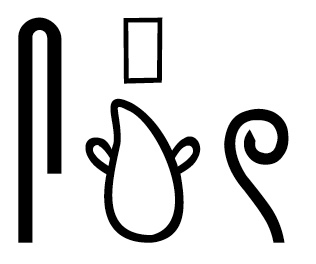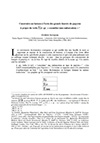bouse de vache
« Construire un bateau Ă l’orĂ©e des grands fourrĂ©s de papyrus. Ă€ propos du verbe  spj, “assembler (une embarcation)” »
spj, “assembler (une embarcation)” »
ENiM 11, 2018, p. 197-224.
 Le verbe spj est habituellement traduit « attacher les parties d’un bateau en papyrus ou en bois ». Cependant, en raison du déterminatif très particulier qui accompagne ce mot, le signe N32 de la liste de Gardiner, qui figure une masse d’excréments ou d’argile, certains chercheurs on fait dériver le sens de ce mot d’un sens primitif signifiant « calfater ». Or, le calfatage est un technique apparaissant tardivement dans la construction des bateaux en bois. Ce signe figure en fait un mélange d’argile et de déjections de bovidés servant à colmater les parties faibles d’une coque en bois.
Le verbe spj est habituellement traduit « attacher les parties d’un bateau en papyrus ou en bois ». Cependant, en raison du déterminatif très particulier qui accompagne ce mot, le signe N32 de la liste de Gardiner, qui figure une masse d’excréments ou d’argile, certains chercheurs on fait dériver le sens de ce mot d’un sens primitif signifiant « calfater ». Or, le calfatage est un technique apparaissant tardivement dans la construction des bateaux en bois. Ce signe figure en fait un mélange d’argile et de déjections de bovidés servant à colmater les parties faibles d’une coque en bois.
 The verb spj is usually translated as « to tie the parts of a boat in papyrus or wood ». However, because of the very particular determinative that accompanies this word, the N32 sign of Gardiner’s list, which is a mass of excrement or clay, some researchers have derived the meaning of this word from a primitive signification meaning « caulk ». However, caulking is a technique that appears late in the construction of wooden boats. This sign is a mixture of clay and dung of cattle used to seal the weak parts of a wooden hull.
The verb spj is usually translated as « to tie the parts of a boat in papyrus or wood ». However, because of the very particular determinative that accompanies this word, the N32 sign of Gardiner’s list, which is a mass of excrement or clay, some researchers have derived the meaning of this word from a primitive signification meaning « caulk ». However, caulking is a technique that appears late in the construction of wooden boats. This sign is a mixture of clay and dung of cattle used to seal the weak parts of a wooden hull.
 Consulter cet article (48023) -
Consulter cet article (48023) -  Télécharger cet article au format pdf (25883)
Télécharger cet article au format pdf (25883)
ENiM 18 - 2025
8 article(s) - 8 octobre 2025.
ENiM 1 à 18 (2008-2025) : 227 articles
5 220 212 téléchargements
10 426 723 consulations.
Index des auteurs

Mots clés

Derniers articles : 
CENiM - Mise en ligne des volumes Ă©puisĂ©s : 
 Anne-Sophie von BOMHARD DĂ©cans Ă©gyptiens, CENiM 23, Montpellier, 2020 — (2020)
Anne-Sophie von BOMHARD DĂ©cans Ă©gyptiens, CENiM 23, Montpellier, 2020 — (2020) 
 Jean-Claude Grenier L'Osiris ANTINOOS, CENiM 1, Montpellier, 2008 — (26 dĂ©cembre 2008)
Jean-Claude Grenier L'Osiris ANTINOOS, CENiM 1, Montpellier, 2008 — (26 dĂ©cembre 2008) 
TDENiM - Mise en ligne des volumes Ă©puisĂ©s : 
 Twitter
Twitter 





















 Contact
Contact